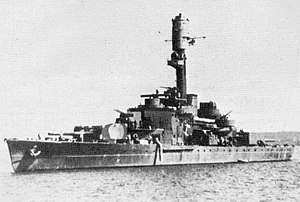Finnish coastal defence ship Ilmarinen
 Väinämöinen, sister ship to Ilmarinen
| |
| History | |
|---|---|
| Name | Ilmarinen |
| Ordered | 1927 |
| Builder | Crichton-Vulcan Oy, Turku, Finland |
| Laid down | September 1929 |
| Launched | 9 July 1931 |
| Commissioned | 17 April 1934 |
| Fate | Sunk by mines on 13 September 1941 |
| General characteristics | |
| Class and type | Väinämöinen-class coastal defence ship |
| Displacement | 3,900 long tons |
| Length | 93.0 m (305.1 ft) |
| Beam | 16.864 m (55.33 ft) |
| Draught | 4.5 m (15 ft) |
| Propulsion |
|
| Speed | 14.5 knots (26.9 km/h; 16.7 mph) |
| Range | 700 nmi (1,300 km; 810 mi) |
| Complement | 403 (11 September 1941) |
| Armament |
|
Ilmarinen was a Finnish Navy Panssarilaiva, Swedish Pansarskepp ("Armored ship"; a coastal defence ship by British classification). The unit was constructed at the Crichton-Vulcan shipyard in Turku, Finland, and named after the mythological hero Ilmarinen from the Finnish national epic, the Kalevala. Ilmarinen was the flagship of the Navy from 1 May 1933 until her sinking on 13 September 1941.
History

During the early inter-war period the Finnish Navy consisted of some 30 ex-Russian vessels, most of them taken as war-trophies following the civil war. Never ideal types for the navy's needs, they were generally old and in poor condition. In 1925, a tragic incident highlighted the sorry state of the navy. An old torpedo boat was lost in a fierce storm, taking with her the entire crew of 53. A heated debate started, and intensive lobbying led to the adoption of a new Finnish Navy Act in 1927.
Prior to World War II, the fleet renewal program led to the acquisition or construction of five submarines, four torpedo boats, and two coastal defense ships. Among the last of their kind, Väinämöinen and Ilmarinen were two of the most concentrated naval artillery units ever built. They were designed by the Dutch company NV Ingenieurskantoor voor Scheepsbouw (a front for German interests circumventing the Treaty of Versailles), and were optimized for operations in the archipelagos of the Baltic Sea. Their open sea performance was de-emphasized in order to give the vessels their shallow draft and super-compact design.
Coastal defence ships were particularly popular in the
Being the second of her class, Ilmarinen was
The vessels had a compact design, with a high mast and large turrets for main and secondary artillery. Foreign comments on their design ranged from puns to praise. Not truly designed for open sea operations, the ships had a tendency to roll slowly and widely even in moderate seas. Travel on them was unpleasant, but deemed safe. Additional keels were later fitted, which improved the situation somewhat.
Väinämöinen and Ilmarinen had a displacement of 3,900 long tons, a maximum length of 93 metres (305 ft), and a
The four 254 mm (10 in)
The purpose of the coastal defence ships was to prevent landing operations and naval blockades that threatened vital sea trade. Thanks to the construction of vast defensive systems during the czarist era, Finland had strong coastal artillery in permanent positions. These defenses were to be supplemented with minefields in times of unrest. One of the main purposes of the navy was to buy time for ground forces to deploy to the islands in the Archipelago. In these confined spaces, coastal defence ships armed with 254 mm main artillery would have been a tough opponent for any ship of the era.
The
Operational history
During her first years Ilmarinen made a few journeys to different ports in Finland, once running aground near Vaasa.
When the Winter War erupted, Ilmarinen and her sister ship Väinämöinen were dispatched to Åland in order to guard against a possible invasion. Due to a decree by the League of Nations, the Ålands were to be demilitarized in peacetime. The Finnish Navy was to transfer resources there when conflict arose.
The threat against the Åland Islands receded after thick sheet-ice began covering the Baltic Sea in December 1939. The two coastal defence ships sailed to Turku where they provided anti-aircraft support for the city. They were painted white to prevent Soviet bomber crews from spotting them, but were targeted by aircraft on several occasions, resulting in one death and several injuries.
During the Continuation War the two ships shelled the Soviet base at Hanko Peninsula on five occasions in July–November 1941.[1] Ilmarinen fired twenty shells at the Soviet airfield at Täcktom on 12 July 1941. The airfield had previously been bombed by German Junkers Ju 88s of Küstenfliegergruppe 806.

The two Finnish coastal defence ship participated in
The survivors were later known as Ilmarisen uimaseura (Ilmarinen's Swimming Club). Among the survivors were Ilmarinen's captain, Commander Ragnar Göransson, and the Commander of the Finnish Navy, Commodore Eero Rahola, as well as Lieutenant Viljo Revell, later a renowned architect.
The loss of Ilmarinen is the greatest single loss of the Finnish Navy to date. The military command tried to keep the loss secret, but Swedish newspapers soon reported the incident, and the numerous sailor obituaries in Finnish newspapers could also have alerted the Soviets, who soon also reported the loss.
The ship was located in 1990. It was found upside-down, deeply embedded in mud, resting at a depth of 70 metres (230 ft). It is classified as a war grave. The wreck of Estonia is some 15 km (9.3 mi) away.
See also
- Väinämöinen, the sister ship of Ilmarinen
- Finnish torpedo boat S2, the second worst Finnish Navy disaster
Footnotes
- ^ Finnish Navy in World War II: Finnish coast defence ships Archived 2008-04-12 at the Wayback Machine
External links
- Pansarfartyget Ilmarinen Archived 2017-06-14 at the Wayback Machine (Finnish)
- World War II Database: Ilmarinen (English)
